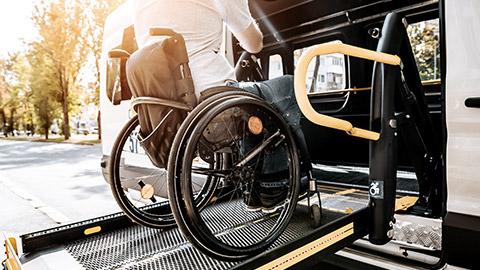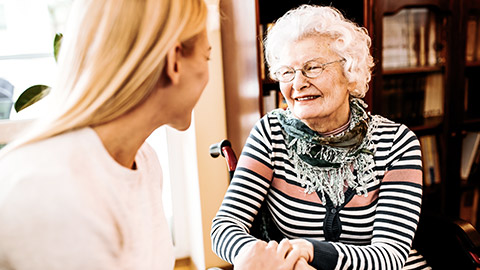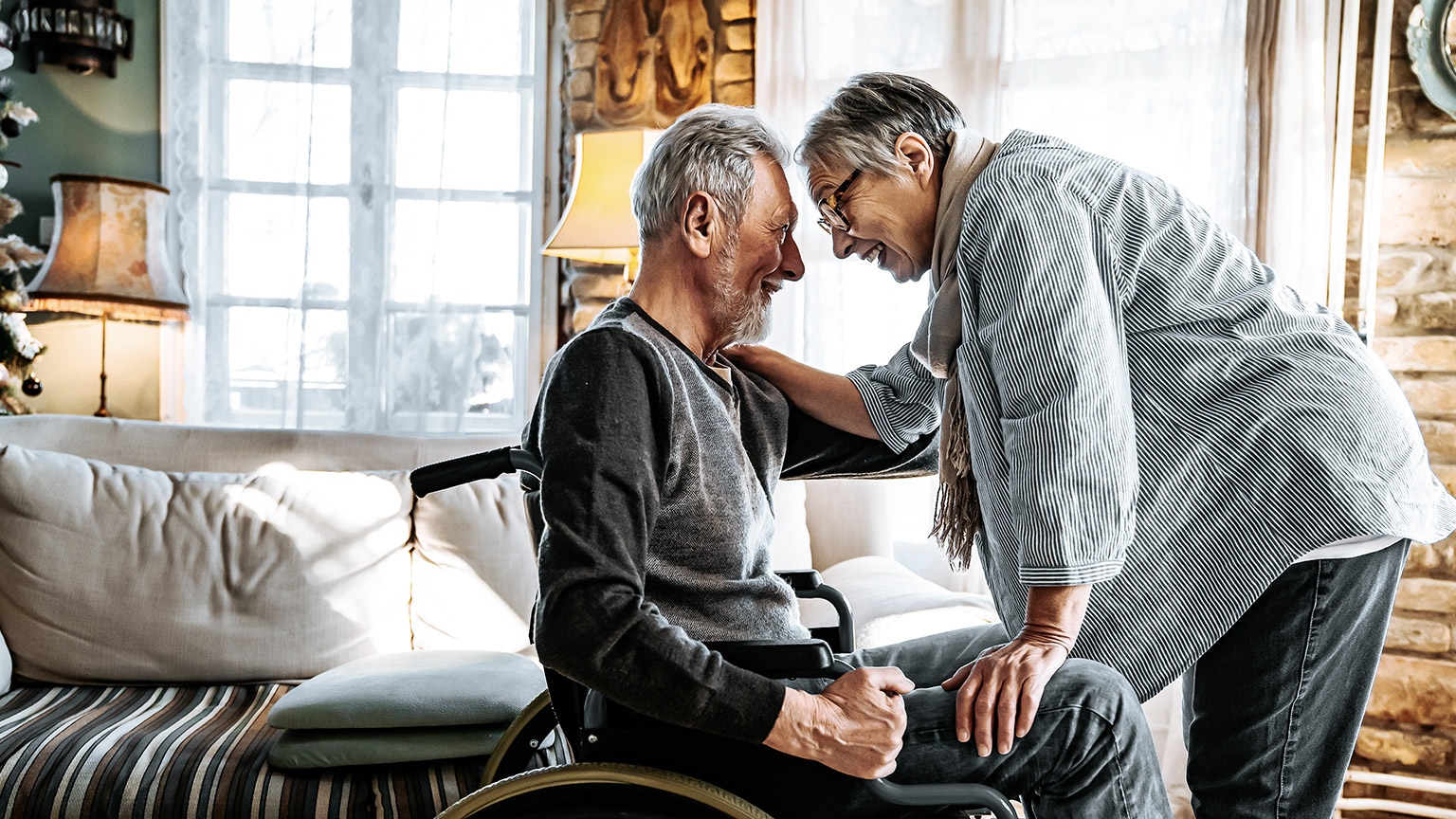In this Topic we will look at:
- Supporting a person to understand their rights.
- Using a person-centred approach to deliver services
- Consulting with a person to confirm their cultural needs and ensure these are respected and prioritised
- Identify breaches of human rights and respond and report accordingly
- Consult with a person to identify indications of abuse and neglect and report accordingly
Fostering human rights in aged care and disability settings involves ensuring that the rights, dignity, and autonomy of older adults and people with disabilities are respected, protected, and promoted.
Persons with disabilities include those who have long-term physical, mental, intellectual, or sensory impairments which in interaction with various barriers may hinder their full and effective participation in society on an equal basis with others.
The Disability Discrimination Act 1992 defines 'disability' as:
- total or partial loss of the person's bodily or mental functions; or
- total or partial loss of a part of the body; or
- the presence in the body of organisms causing disease or illness; or
- the presence in the body of organisms capable of causing disease or illness; or
- the malfunction, malformation, or disfigurement of a part of the person's body; or
- a disorder or malfunction that results in the person learning differently from a person without the disorder or malfunction; or
- a disorder, illness or disease that affects a person's thought processes, perception of reality, emotions, or judgment or that results in disturbed behaviour.
and includes a disability that:
- presently exists; or
- previously existed but no longer exists; or
- may exist in the future (including because of a genetic predisposition to that disability); or
- is imputed to a person.
To avoid doubt, a disability that is otherwise covered by this definition includes behaviour that is a symptom or manifestation of the disability.
What are rights of people with disability?
The Convention on the Rights of Persons with Disabilities (CRPD) recognises the barriers that people with a disability may face in realising their rights. The rights under all human rights treaties apply to everyone, including people with disability. However, the CRPD applies human rights specifically to the context of people with disability.
Where do the rights of people with disability come from?

Australia is a party to seven core international human rights treaties. The rights of people with disability are contained in the Convention on the Rights of Persons with Disabilities (CRPD). Some of the more significant rights that are particular to people with disability are extracted in the section 'Articles from relevant Conventions' and are discussed below. These include articles 4(3), 5, 9(1), 19, 26(1) and 33.
You will need to consider the rights accorded to people with disability when you are working on legislation, a policy, or a program that relates access to:
- buildings, roads, transport and public facilities like schools, housing, hospitals, clinics, and workplace
- information, communications, and other services, including electronic services like the Internet and emergency services
- public services such as education and healthcare, public institutions such as the justice system and courts and other public activities such as voting and advocacy
- employment
- an adequate standard of living, including adequate food, clothing, and housing
- in-home, residential, and other community support services, or
- mobility aids, assistive devices and technologies designed for people with disabilities.
- sets standards and guidelines for access to facilities and services to ensure that private businesses that provide facilities or services to the public consider access for people with disability, and/or
- relates to capacity to make decisions or legal rights and recognition before the law.
Source: Rights of People with Disability
The United Nations Convention on the Rights of Persons with Disabilities explains the purpose to ensure equal rights and dignity for individuals with disabilities. It highlights Australia's involvement as an original signatory, including its adoption of the Convention and the Optional Protocol. The page provides information on the Convention’s significance in promoting and protecting disability rights in Australia.
Read
For further information about the Charter, access the following link: United Nations Convention on the Rights of Persons with Disabilities (UNCRPD)
Watch
Rights Under the UN Convention on the Rights of Persons with Disability (UNCRPD)
Legal and ethical considerations for working with people receiving support
Codes of conduct
Codes of conduct are a set of documents that provide guidance to staff on appropriate ethical standards for work-related behaviour and is generally based on the values of the organisation. For instance, integrity, accountability, and transparency.
Discrimination
Discrimination happens when a person or group of people actively treat a person differently because of a factor that is irrelevant. For example, it is discrimination to refuse to give a person employment simply because of age or disability, if the person can do the job in the same way that a younger, non- disabled person can do. People who belong to certain groups, such as people with disabilities, mental health conditions, people from certain races and ethnicities, people who identify as LGBTIQ and people from low socio-economic backgrounds can find that they are not able to access the same opportunities as other people in society. This can lead to further disadvantage, including cycles of poverty, poor health, social exclusion, and increased incidence of mental health issues. Discrimination, both direct and indirect, still contributes to this cycle in Australia.
Direct discrimination is illegal. It refers to treating a person differently or unfairly in their access to services or venues in society based on a protected and irrelevant trait, including gender, sexuality, cultural background, religious beliefs, English-speaking status, age, race, and disability. People with mental health conditions frequently find themselves the victim of direct discrimination. This means that the person has been directly refused fair access because of traits that are not relevant to the situation. This can affect their ability to obtain work because they have disclosed a mental illness; their ability to access rental accommodation; and their access to the full recreational, creative, spiritual, sporting, and other opportunities in society that most of us enjoy. Other people are victims of indirect discrimination. This means that the person is not able to fully access public and private services because of rules that make it more difficult for them to pass through.
Dignity of risk
Dignity of risk means the person has the right to take some risks in their everyday life, even if others do not approve, and even if it is not the best or safest thing for the person. Dignity of risk allows the person to make choices, even if we do not agree that they are the right ones. The person should be allowed the dignity of risk when the following three things are considered: 1. You have helped them to learn about the consequences of their decision if they were not aware of the risk 2. They can understand the consequences of their decision 3. The choice they are making does not have the potential to harm anyone else.
Duty of care
Community and health facilities have a legal obligation to provide a duty of care to their clients. Failing to act potentially places the client and others in danger.
You should discuss duty of care requirements with your supervisor, so you understand fully the expectations of your workplace. You may be required to use tools or assessments to help you decide the duty of care which you owe to a person, and how you should exercise your duty.
Model WHS Act health and safety legislation states a person conducting a business or undertaking (PCBU) has a duty of care to maintain a healthy and safe workplace. Employers are generally regarded as PCBUs and are legally obliged to ensure workers can carry out their work safely and without risk to their health. The ethical consideration here would be to always follow principles of respect for all persons you are caring for. In day-to-day work duty of care is the legal duty to take reasonable care so that others aren't harmed and involves identifying risks and taking reasonable care in your response to these risks. It is the employer's responsibility to ensure that all reasonably practicable measures have been taken to control risks against all possible injuries arising from the workplace. The employer's duty of care applies to all people in the workplace, including visitors, contractors etc. Legal liabilities may arise if facility or workers are in breach of their duty of care and if client care is sub-standard. Failure at audit – rectifications, fines, cancellation of registration
Human rights

Human rights lie at the heart of ethical decision making. Human rights are fundamental to the way we interact with other people and the value we see in their ability to survive and thrive in our society.
Human rights recognise that each person, regardless of their backgrounds have the right to be treated fairly, with dignity and mutual respect and can make their own daily life choices.
The Universal Declaration of Human Rights was adopted by the United Nations General Assembly in 1948. The declaration is not legally binding for the countries who have signed it, but it does set out an important set of agreements and understandings about what human rights mean for the world.
The declaration begins by acknowledging that ‘the inherent dignity of all members of the human family is the foundation of freedom, justice and peace in the world.’
When we are working within the aged care and disability sectors it is very important to be mindful of workplace policies, procedures, legislation, and regulations that we need to adhere to when we are supporting clients.
Some of these include the following:
- Aged Care Act 1997
- Aged Care Guidelines
- Aged Care Diversity Frameworks
- The Aged Care Quality Standards
- The Charter of Aged Care Rights
- User Rights Principles
- Disability Inclusion Act 2023
- Disability Discrimination Act (1992)
- Racial Discrimination Act 1975
- Sexual Discrimination Act 1984
- National Disability Insurance Scheme Act (2013)
Important
This information is not exhaustive but contains examples of the types of information relating to the different frameworks in which support work is undertaken.
Mandatory reporting
The laws related to mandatory reporting vary across the states and territories. Mandatory reporting sets out the requirements for making a report about known or suspected child abuse, neglect, harm, or risk because of circumstances which exist within their current living arrangement. There are differences about who must make a report and the types of abuse which must be reported. In some locations, any adult with a reasonable belief is required to make a report, while in other locations, only particular groups of people must report.
Privacy, confidentiality, and disclosure
Maintaining privacy and confidentiality is a law that protects people's privacy and confidentiality and is part of respecting a person's individual rights. In practice, confidentiality means not discussing an individual's personal information unless they have given their consent for this to happen. There are exceptional circumstances that enable you to disclose private information, but this is generally only when you become aware that someone may be harmed or is enforced by the law.
Work role boundaries, responsibilities, and limitations
As an aged care worker or a disability support worker in Australia, it is important to understand and operate within certain work role boundaries, responsibilities, and limitations. These may vary depending on the specific job role, employer, and relevant laws and regulations.
Work role boundaries refer to the limits of what is expected and permitted within your job role. It is important to understand and respect these boundaries to ensure that you are working within your scope of practice and not exceeding your qualifications, skills, and legal authority. Boundaries may include not providing services or interventions that are outside your training or expertise, not engaging in activities that are unethical or illegal, and not overstepping professional boundaries with clients or colleagues.
Example - Work Responsibilities
An aged care worker who is not trained or authorised to administer medications should not attempt to administer medication to a client, even if asked by the client or their family. This is beyond the worker's scope of practice and exceeds their qualifications and legal authority.
Work responsibilities refer to the tasks, duties, and obligations that are associated with your job role. As an aged care worker or disability support worker, your responsibilities may include providing care and support to clients in accordance with their individual care plans, promoting their health and well-being, ensuring their safety and dignity, maintaining accurate documentation, adhering to relevant policies and procedures, communicating effectively with clients, families, and colleagues, and seeking appropriate guidance or assistance when needed.
Example - Work Responsibilities
A disability support worker is responsible for helping with daily living activities, such as bathing, dressing, and meal preparation, as outlined in the individual care plan of a client with disability. The worker should ensure that these responsibilities are carried out in a safe and appropriate manner, following relevant policies, procedures, and guidelines.
Work limitations refer to the constraints and restrictions that may be in place due to legal, organisational, or professional factors. It is important to be aware of these limitations and not exceed them in your job role. Limitations may include not providing services or interventions that are prohibited by law, not disclosing confidential information without proper consent or legal authority, not making decisions, or taking actions that are beyond your level of authority, and not engaging in practices that are considered discriminatory, abusive, or unethical.
Example - Privacy and confidentiality
An aged care worker is not allowed to disclose a client's personal health information to anyone without proper consent, unless required by law or in case of an emergency. The worker should respect the confidentiality and privacy of the client's information and only share it with authorised individuals or entities as per the organisation's policies and procedures.
Work Health and Safety
Health and safety are the concerns of every person who enters a workplace. Legislation outlines the roles and responsibilities of every Australian employer and worker to protect yourself and others from harm. In the community services workplace, this includes the safety of clients or residents, family members, visitors, and volunteers. These laws are made and enforced by different levels of government.
Here are some examples of National Laws and Regulations in Australia:
- The Commonwealth (Australian Government) National work health and safety laws, such as the Workplace Health and Safety Act 2011 (Cwth
- State and territory governments, State and territory legislation and regulations regarding workplace safety, such as codes of practice
- Local councils and shires Local council bylaws, such as building codes and food safety
Legislated, statutory, professional, and ethical standards
Legislated, statutory, professional, and ethical standards play a critical role in ensuring the well-being and protection of individuals who are ageing or living with disabilities. These standards provide guidelines, regulations, and expectations for various stakeholders involved in the care and support of older adults and individuals with disabilities, including caregivers, service providers, policymakers, and organisations.
The following information are examples of various principles that relate to legislated statutory, professional, and ethical standards:
Empowerment

Empowerment means ‘giving the person power’. This is an especially important principle in support work. It is a basic human right to have control over our own life and decisions. When the person feels confident about feeling in control of themselves and their own choices, we give them power.
There are many ways to help the people you support to express their own preferences and to gain confidence in speaking up about their own wishes. You hand over this power to the person when you:
- Talk to them as someone who is providing a service, rather than as someone who is in charge
- Tell them about their rights and how to use them.
- Remind the person often that they are their own expert, and that they have the right to express their own wishes.
- Do not just say it, do it—Treat the person as an expert about their own needs and preferences whenever you can
- Help them practice making choices, such as exploring options together, rather than simply telling them what you think they should do.
- Try to practice using open-ended questions like ‘What would you like to do today?’ rather than providing your own options.
- Help the person practice saying ‘No’ to what they do not want
- Respect the person’s reasonable final decisions without question unless it is not safe for them to do so.
- Be conscious of your facial expressions and how you respond to the person’s own choices.
- Avoid showing displeasure or annoyance, even in subtle ways, when you do not agree with the person’s choices. Different choices are what make us unique.
| Principle | Description |
|---|---|
| Human rights | Recognising that older Australians and people with disabilities have fundamental human rights, including the right to life, liberty, security, equality, and non-discrimination. It also acknowledges their right to participate in decision-making processes that affect their lives, and to have their choices and preferences respected. |
| Person-centredness | Prioritises the unique needs, preferences, and goals of older Australians and people with disabilities, and emphasises the importance of tailoring care and support services to meet their individual needs. It promotes a holistic and inclusive approach that considers the physical, emotional, social, and cultural well-being of individuals. |
| Empowerment | Seeks to empower older Australians and people with disabilities by promoting their autonomy, independence, and self-determination. It recognises their right to be active and engaged members of their communities, and promotes opportunities for participation, inclusion, and social connection. |
| Accessibility | Emphasises the need for physical, communication, and information accessibility to ensure that older Australians and people with disabilities can access services, facilities, and information without discrimination or barriers. It promotes the use of inclusive design principles and reasonable accommodations to facilitate full and equal participation. |
| Accountability | Holds service providers, policymakers, and other stakeholders accountable for upholding the rights of older Australians and people with disabilities. It encourages transparency, accountability, and continuous improvement in the provision of aged care and disability services, and promotes mechanisms for complaints, feedback, and redress. |
A rights-based approach in aged care and disability in Australia is aligned with international human rights frameworks, such as the United Nations Convention on the Rights of Persons with Disabilities (CRPD) and the Universal Declaration of Human Rights (UDHR), and is aimed at promoting dignity, inclusion, and well-being for older Australians and people with disabilities.
Watch
The following video provides discussions about a human rights based approach
Person-centred practices
Person-centered practices in Australia refer to an approach to care and support that prioritises the individual's needs, preferences, and goals, and involves them as an active partner in their care and decision-making. Person-centered care aims to respect the person's autonomy, dignity, and cultural background, and to provide care that is responsive, inclusive, and empowering.
For example:
Consumer-Directed Care (CDC) in Aged Care: CDC is an approach to aged care that gives older adults more choice and control over their care and services. It allows consumers to make decisions about their care plan, service providers, and the type of services they receive, based on their individual needs and preferences. CDC promotes person-centered care by involving older adults in decision-making, supporting their autonomy, and tailoring care plans to their unique needs and preferences.
Shared Decision-Making: Shared decision-making is an approach that involves individuals as active partners in their healthcare decisions. It involves healthcare professionals and individuals working collaboratively to develop a care plan that aligns with the individual's values, preferences, and goals. Shared decision-making respects the autonomy and choices of the individual and encourages their active participation in their care.
Culturally Sensitive Care: Culturally sensitive care is an important aspect of person-centered care that recognises and respects the cultural background, beliefs, and practices of individuals. It involves understanding and valuing the diversity of cultures and providing care that is inclusive, respectful, and responsive to the cultural needs and preferences of individuals.
Strengths-Based Approach: The strengths-based approach focuses on identifying and building upon the strengths, abilities, and resources of individuals, rather than focusing solely on their deficits and limitations. It encourages individuals to participate in decision-making, set goals based on their strengths and abilities, and be active partners in their care and support.
Person-Centered Planning: Person-centered planning is a process that involves individuals, their families, and their support networks in developing a plan that reflects the individual's needs, preferences, and goals. It involves listening to the individual's voice, respecting their choices, and tailoring the care and support plan to their unique needs and preferences.
Scenario – Person centred approach

Mr. Johns, a 75-year-old man with mild cognitive impairment and physical limitations due to osteoarthritis, residing in a residential aged care facility is supported by Jenna, an experienced support worker who provides care and support to him as part of the aged care facility's care team.
Jenna practices a person-centred approach with Mr Johns through:
Jenna takes the time to build a trusting and meaningful relationship with Mr Johns by getting to know him as an individual. She learns about his personal preferences, interests, and life history to better understand his unique needs, abilities, and limitations. Jenna also communicates regularly with Mr. Smith's family and involves them in care planning and decision-making, recognising their role as important stakeholders in his care. She recognises his right to make choices and decisions about his own care and respects his autonomy. She involves him in his care planning, seeks his input, and encourages him to express his preferences and wishes. Jenna actively listens to Mr. Smith's concerns, questions, and feedback, and takes them into consideration in developing his care plan.
Jenna collaborates with him, his family, and the interdisciplinary care team to develop a care plan that reflects his unique needs, preferences, and goals. The care plan includes strategies to support Mr. John’s physical, cognitive, emotional, and social well-being, and is regularly reviewed and updated based on his changing needs and preferences.
Jenna tailors her care and support to his individual needs and preferences and helps him with personal care activities such as bathing, dressing, and grooming, taking into consideration his physical limitations and cognitive impairment. She also engages him in meaningful activities based on his interests and abilities, such as reading, listening to music, and reminiscing about his life experiences. She works closely with other members of the care team, such as the registered nurse, allied health professionals, and other support workers, to provide holistic care to him. She actively communicates and shares relevant information with the care team to ensure a coordinated and person-centered approach to his care. Jenna also advocates for Mr. John’s needs and preferences within the care team and promotes a collaborative and inclusive care culture.
She regularly reflects on her practice and seeks feedback from Mr. Johns, his family, and the care team to identify areas for improvement. She engages in ongoing professional development and education to enhance her knowledge and skills in providing person-centered care in aged care and disability settings.
As a result Mr. Johns feels respected, valued, and empowered in his care. He is actively involved in his care planning and decision-making, and his preferences and goals are considered in his care. His physical, cognitive, emotional, and social well-being are supported, and he experiences a higher quality of life despite his limitations. His family feels engaged, informed, and supported in his care, and the care team works collaboratively to provide.
Self-advocacy
Self-advocacy refers to individuals with aged care or disabilities advocating for their own needs, rights, and preferences. It involves empowering individuals to express their opinions, make choices, and participate in decision-making about their own care and support.
Watch
The following video talks about self-advocacy and speaking up!
Scenario: Mr Johnson

This case study demonstrates how self-advocacy can be supported in an aged care setting by recognising and respecting an individual's expressed preferences and needs, even when they may have difficulty communicating due to cognitive decline. By empowering Mrs. Jones to express her desire for a walk and honouring her request, the care team promotes her autonomy, dignity, and well-being, and enhances her quality of life in the aged care facility.
Meet Mr. Johnson, an 85-year-old resident in an aged care facility. Over the past few months, Mr. Johnson has expressed his desire to have more control and involvement in decisions regarding his daily routine and care. He feels that his preferences and needs are not always considered, leading to frustration and a diminished sense of independence. Recognising the importance of self-advocacy, the facility staff decides to actively support Mr. Johnson in expressing his preferences and needs effectively.
One morning, during a routine care meeting, the facility's care team, including nurses, social workers, and support staff, gather to discuss Mr. Johnson's concerns. They understand the significance of recognizing and respecting his expressed preferences and needs. The team engages in active listening, allowing Mr. Johnson to express his frustrations and desires openly. They create a safe space where he feels comfortable sharing his thoughts and concerns. Through their empathetic approach, the team gains a deeper understanding of Mr. Johnson's desire for autonomy and a sense of control over his own life.
To ensure Mr. Johnson's active involvement in decision-making, the care team collaborates with him to establish a shared decision-making process. They discuss various aspects of his care, such as meal choices, daily routines, social interactions, and recreational activities. Mr. Johnson feels valued and empowered as the team seeks his input, taking his preferences into account. With this newfound collaboration, the facility develops an individualized care plan for Mr. Johnson. The plan reflects his expressed preferences and needs, allowing him to have a say in his own care. The team carefully considers his desired routines, dietary requirements, and personal interests, ensuring that the plan is tailored to his individual needs.
Regular communication and feedback play a vital role in supporting Mr. Johnson's self-advocacy. The care team encourages him to provide ongoing feedback on his experience within the facility. This feedback loop helps address any concerns promptly and ensures that his needs are consistently met. Recognising the importance of education and empowerment, the facility provides Mr. Johnson with information about his rights, entitlements, and the importance of self-advocacy. They equip him with the knowledge and communication skills necessary to express his preferences and needs effectively.
Throughout his interactions with the care team, Mr. Johnson experiences a shift in the way he is treated. He feels respected, heard, and empowered to make decisions about his care. The staff members honor his choices whenever possible, always maintaining a balance between his safety and well-being. As a result of the facility's efforts to support his self-advocacy, Mr. Johnson's overall well-being improves. He gains confidence in expressing his preferences and needs, enhancing his sense of control and independence. The person-centered approach employed by the care team not only benefits Mr. Johnson but also sets an example for others in the facility, fostering a culture of respect, dignity, and self-advocacy among residents and staff alike.
Active support
Active support is an approach that focuses on providing the necessary support to individuals with aged care or disabilities to enable them to participate in meaningful activities and fully engage in their community if possible. It involves working alongside individuals, rather than doing things for them, and promoting independence, choice, and skill development.
Case study

John is a young man with a physical disability who lives in a supported living arrangement. He has a passion for cooking and enjoys preparing meals for himself and his housemates. However, due to his physical limitations, he requires assistance with certain tasks in the kitchen.
The support staff at John's residence adopt an active support approach to promote his independence and engagement in his preferred activity. They work alongside John in the kitchen, providing the necessary support for him to chop vegetables, measure ingredients, and use kitchen appliances safely. They also encourage John to make choices about the meals he wants to prepare and involve him in planning and grocery shopping.
Over time, John's cooking skills improve, and he gains more confidence in the kitchen. He can prepare meals for himself and his housemates with minimal assistance, and he takes pride in his culinary accomplishments. The support staff continue to provide encouragement, guidance, and praise, and they adjust the level of support based on John's evolving skills and preferences.
Active listening
Active listening is a communication technique that involves fully focusing on the person speaking, and seeking to understand their thoughts, feelings, and perspectives without interrupting or passing judgment. It is an important skill for caregivers and support providers in aged care and disability settings to effectively understand and respond to the needs and preferences of individuals they are supporting.
Case study

Sarah is currently feeling distressed. The support staff adopt an active listening approach to understand Sarah's needs and communicate effectively with her. They observe her closely, pay attention to her body language, facial expressions, and vocalisations, and provide her with ample time and space to express herself. They avoid interrupting or finishing her sentences and refrain from making assumptions about her needs or preferences.
Through active listening, the support staff notice that Sarah seems to be trying to communicate something related to her discomfort with a change in her daily routine. They take the time to listen and understand her communication cues, and they work collaboratively with Sarah's speech therapist to develop new communication strategies tailored to her unique communication style.
As a result of the active listening approach, Sarah's distress is alleviated, and she can communicate her concerns and preferences more effectively. The support staff can address the changes in her routine and provide appropriate support to help her feel more comfortable and engaged in her daily activities.
Social justice, and the importance of knowing and respecting each person as an individual
Social justice is the concept of promoting fairness, equality, and inclusiveness in society. In the context of aged care and disability, it involves advocating for the rights, dignity, and well-being of individuals with aged care or disabilities, and working towards creating an inclusive and equitable environment that respects and values diversity.
Case study

Mrs. Patel, an 80-year-old resident in an aged care facility, feels that her cultural needs are not being respected by the staff. The facility takes immediate action to address this issue and ensure social justice. The care team arranges a meeting with Mrs. Patel, actively listening to her concerns about cultural understanding and respect. They collaborate with her to develop a culturally sensitive care plan that includes dietary requirements, religious practices, and language preferences.
The facility provides cultural sensitivity training to staff, promoting an inclusive environment where individual rights are valued. Mrs. Patel is empowered to voice her needs and preferences, knowing her choices are respected. The facility organizes cultural events and activities, fostering social inclusion and celebrating diverse traditions. Mrs. Patel experiences a positive change in her care, feeling acknowledged and valued for her cultural identity. Through their commitment to social justice, the facility creates an atmosphere where all residents are treated with respect and dignity, promoting a culture of inclusivity.
Strengths-based approaches
Case study

Emily is a young woman with autism who is receiving support in a day program. She has challenges with social interactions and communication but has a keen interest in drawing and painting. The staff at the day program adopt a strengths-based approach to support Emily in pursuing her passion for art.
The staff observe Emily's artistic talents and provide her with opportunities to engage in various art activities, such as painting, drawing, and collaging. They encourage her to express herself creatively and provide positive feedback and praise for her artistic endeavours. They also seek input from Emily about her preferred art materials, techniques, and themes.
As Emily becomes more involved in art, the staff recognize her strengths and abilities in this area. They collaborate with an art therapist to develop a personalized art program for Emily, tailored to her interests and abilities. They also involve Emily in showcasing her artwork in the day program and local community, boosting her self-esteem and confidence.
Over time, Emily's art skills and confidence improve, and she becomes more socially engaged with her peers in the day program. She gains a sense of accomplishment and purpose through her artistic pursuits, and her overall well-being and quality of life are enhanced.
Disability
The Disability Act 2006 protects the rights of people with disability who submit to the use of restrictive practices or compulsory treatment. A small number of people with a disability are subject to restrictive practices or compulsory treatment, which are used to protect the person from causing harm to themselves or others.
The use of regulated restrictive practices by disability service providers must be included in a behaviour support plan and reported to the Victorian Senior Practitioner.
The use of regulated restrictive practices by registered NDIS providers must be included in a NDIS behaviour support plan prepared by a NDIS behaviour support practitioner and reported to the NDIS Quality and Safeguards Commission.
When can restrictive practices be used?
Everybody has a right to move freely, but sometimes people might hurt themselves or hurt other people. Providers can use restrictive practices to stop harm to self or to others.
Physical restrictive practices
- Some common restrictive practices in residential aged care that are physical can include:
- clasping a person's hands or feet to stop them from moving
- applying restraints such as leg, wrist, ankle, or vest restraints
- seating residents in chairs with deeper seats, recliners, or rockers where they are unable to stand up from, or moving their mobility aids
- It may also include confiding a person in a residential facility or specialised unit
Pharmacological restrictive practices
Some medications prescribed for residents in residential aged care can have the effect of restricting a person's movements or their ability to make decisions. Some medications may cause sedation and can be prescribed for pain relief, whilst others such as psychotropic medication can include stimulants, antidepressants, anti-psychotics, mood stabilisers and anti-anxiety agents.
Physical restraint effects
The use of restrictive practice can present with serious human rights breaches therefore it is crucial that ethical consideration is considered. While in certain circumstances, physical restraint may be necessary to mitigate risks to a resident or others in an emergency, the impacts on a person receiving physical restraint can include: shame fear anxiety loss of dignity agitation lower cognitive performance; and depression
Documentation Requirements
Under the NDIS Rules 2018, all regulated restrictive practices must be thoroughly detailed in a Behaviour Support Plan. This document includes information about triggering behaviours and what causes them and how to reduce or stop the behaviours from happening.
The following points are helpful to consider in a behaviour support plan:
- What is the description of the restrictive practice to be considered
- Why is it being used?
- What strategies were tried before restrictive practice was considered?
- Process - What detailed instructions about how, where, when the restrictive practice will be used and for how long?
- Recording - How will you make sure that all incidents are recorded or reviewed? How will you monitor the effectiveness of the restrictive practice and how will you monitor any side effects?
- What strategies do you have in place to reduce or eliminate the restrictive practice?
- Training - How will training occur with key staff about restrictive practices?
The following table provides information about various methods to address various barriers:
| Barrier | Ways to Address |
|---|---|
| Physical |
|
| Social |
|
| Cognitive |
|
Watch
This video provides an explanation of Restrictive Practices.
Working with a person-centered approach to deliver services that ensure the rights and needs of individuals are upheld in aged care and disability involves several key strategies to consider.
These can include:
- Establishing a trusting and respectful relationship with the individual based on empathy, active listening, and mutual respect.
- Recognising and valuing their unique qualities, preferences, and perspectives.
- Taking the time to understand the individual's rights, needs, and desires through thorough assessment, observation, and communication. Being aware of their legal and human rights, including the right to autonomy, dignity, privacy, and choice.
- Actively involving the individual in the development of their care plan, treatment decisions, and goal setting. Encouraging them to express their preferences, desires, and concerns, and actively involving them in decisions that affect their care and support.
- Tailoring services and support to meet the individual's unique needs, interests, and abilities. Taking into consideration their preferences, cultural background, language, and communication style, and making reasonable accommodations to ensure their comfort and well-being.
- Collaborating with the individual, their family, friends, and other members of their support network in decision-making and care planning. Recognising and respecting the role of the individual and their support network in making choices and decisions about their care and support.
- Providing the individual with clear, accurate, and accessible information about their care, rights, and options.
- Using communication methods that are appropriate for their cognitive, sensory, and linguistic abilities, and ensuring that they have the information they need to make informed decisions.

Consulting with the person to confirm cultural needs and prioritising these in service delivery is important because it shows a respect for their individual autonomy, it allows care providers and workers to gain cultural competence and cultural sensitivity. It enhances communication and trust with the person, improves positive outcomes and respects, values and prioritises their human rights, encourages inclusiveness, diversity and avoids discrimination, stigma, and marginalisation.
Some strategies to ensure we respect and prioritise services when working with people from cultural linguistic diverse backgrounds include:
- Acknowledging and appreciating the cultural diversity of the person and their background. Understand that culture encompasses various aspects such as language, customs, beliefs, values, traditions, and social norms, and that it plays a significant role in shaping an individual's identity and preferences.
- Initiating open and respectful communication by creating a safe and supportive environment where the person feels comfortable expressing their cultural needs and expectations. Use open-ended questions and active listening skills to understand their cultural background, preferences, and any specific requirements they may have in terms of service delivery.
- Collaborating with the person and their support network, including family, friends, and community members, in the care planning process. Seek their input and perspectives on how cultural needs can be respected and prioritised in service delivery.
- Respect their role as the experts on their own culture and involve them in decision-making.
- Tailoring services to align with the person's cultural needs and preferences, as much as possible. This may include accommodating dietary preferences, providing language interpretation or translation services, observing cultural practices, and creating a culturally inclusive environment.

The human rights framework for service delivery is primarily based on the principles and provisions of the Universal Declaration of Human Rights (UDHR) and other international human rights instruments, as well as national and state/territory laws, policies, and guidelines.
When consulting with an individual to identify any form of breach of their human rights it is critical to familiarise yourself with your organisation's policies, procedures and workplace practices that govern the identification and reporting of breaches of human rights. Understanding the steps, roles, and responsibilities outlined in these policies, ensure that you comply with them in your actions and communications.
You may utilise the following skills and expertise when eliciting information to identify a breach:
Engage in active listening
Listen to their concerns, experiences, and perspectives without interruption or judgment. Show empathy and respect for their feelings and opinions and create a safe and non-judgmental environment for open communication.
Consent
Obtain explicit consent from the person before discussing their concerns with others, and explain the purpose, process, and potential outcomes of the consultation. Ensure that the person understands their rights and has the autonomy to make informed decisions.
Open-Ended Questions
Use open-ended questions to encourage the person to express their thoughts and experiences in their own words. Avoid leading questions or assumptions that may bias their responses. Take notes to document their input accurately.
Stay within the Scope of Your Job Role
Recognise and respect the boundaries of your job role and responsibilities. Refrain from making promises or commitments that are outside the scope of your role. Seek guidance or involve appropriate personnel, such as managers, supervisors, or designated human rights officers, when necessary.
Respond Appropriately
Based on the information gathered from the person, respond in an appropriate and timely manner. Address their concerns within the scope of your job role and organizational policies. Offer support, provide information, and collaborate with relevant personnel to identify and implement solutions to breaches of human rights.
Report According to Organizational Procedures
Follow the organisational procedures for reporting breaches of human rights. Complete required documentation accurately and promptly, and report to designated personnel or authorities as per the policies and procedures. Maintain confidentiality and protect the person's privacy, unless required by law or organizational policies.
Follow-Up and Review
Follow up with the person to ensure that their concerns are addressed satisfactorily and monitor the situation for any changes. Review the outcomes of the response and reporting process and identify opportunities for improvement in the future.
Important
It is important to ensure that your actions are in line with the organizational policies, procedures, and legal requirements, and that you advocate for the rights and well-being of the person throughout the process. If in doubt, always seek guidance from your supervisor/manager to ensure that you are acting in a responsible and ethical manner.
Read
This article is a response from People with Disability Australia (PWDA) to a discussion paper released by the National Disability Services (NDS) in Australia, which outlines a proposed framework for measuring outcomes for people with disability receiving support services.
People with Disability Australia (PWDA) Link
This following article was commissioned by the Royal Commission into Aged Care Quality and Safety in Australia and contributes to the development recommendations aimed at improving the lives of older Australians.

Consulting with the person, particularly if they have a disability or are ageing, is a crucial step in identifying indications of abuse and neglect. It is essential to follow organisational policies and procedures, as well as legislative requirements, when responding to suspected abuse or neglect.
Some examples to support an individual are to:
- Create an environment where the person feels comfortable and safe to disclose any concerns. Build rapport and trust by actively listening, showing empathy, and respecting their autonomy and choices. Ask open-ended questions that encourage the person to share their experiences and observations without leading them to a particular response. Avoid using leading or suggestive language that may influence their answers.
- Look for physical, emotional, and behavioural indicators of abuse or neglect, such as unexplained bruises or injuries, changes in behaviour or mood, withdrawal from social activities, fear or anxiety, and changes in personal hygiene or living conditions.
- Pay attention to the person's verbal and non-verbal cues, as they may provide important clues about their well-being. Respect their boundaries and do not press for information they are not comfortable sharing.
- Refer to your organisation's policies and procedures for reporting suspected abuse or neglect. This may involve notifying a supervisor, designated safeguarding officer, or another appropriate authority within the organisation.
- Familiarise yourself with the relevant laws and regulations in your jurisdiction regarding reporting of abuse or neglect. Follow the legal requirements for reporting, which may include notifying law enforcement, adult protective services, or other relevant agencies.
- Respect the person's privacy and confidentiality throughout the process, while also adhering to legal requirements for reporting. Share information only with authorised personnel who are involved in the investigation or intervention.
- Keep accurate and detailed records of your observations, conversations, and actions taken, following your organisation's documentation procedures. This information may be used as evidence in investigations or legal proceedings.
Indicators of abuse, exploitation and neglect
Indicators of abuse, exploitation, and neglect can vary depending on the type of abuse and the individual's age, ability, and circumstances. However, here are some general indicators that may raise concerns:
- Physical Abuse:
- Unexplained bruises, cuts, burns, or injuries.
- Broken bones or fractures.
- Signs of restraint, such as rope marks or bruising.
- Inconsistent or implausible explanations about injuries.
- Fear or avoidance of specific individuals or situations.
- Changes in behaviour, such as aggression or withdrawal.
- Emotional or Psychological Abuse:
- Verbal or non-verbal threats, insults, or humiliation.
- Intimidation, belittling, or ridiculing.
- Social isolation or withdrawal from activities.
- Emotional distress, depression, or anxiety.
- Unusual changes in behaviour or mood.
- Loss of interest in previously enjoyed activities.
- Financial Exploitation:
- Unexplained or sudden changes in financial situation, such as missing money or valuables.
- Unusual or unauthorised use of the individual's funds or assets.
- Forged signatures on financial documents.
- Coercion, deception, or manipulation to gain control over the individual's financial resources.
- Sudden changes in estate planning or wills.
- Neglect:
- Poor personal hygiene, dirty clothing, or unkempt appearance.
- Malnutrition, dehydration, or unexplained weight loss.
- Inadequate medical care or untreated health conditions.
- Unsafe or unsanitary living conditions.
- Lack of appropriate clothing, shelter, or necessities.
- Social isolation or abandonment.
Sexual Abuse
- Unexplained injuries to the genital or anal area.
- Torn or stained underclothing.
- Bruising or bleeding in the genital or breast areas.
- Unexplained sexually transmitted infections (STIs).
- Changes in behaviour or mood, particularly related to sexual matters.
- Fear or avoidance of specific individuals or situations.
It's important to note that these indicators may not always indicate abuse, exploitation, or neglect, and other factors may also contribute to similar signs or symptoms. It's crucial to approach any suspected abuse, exploitation, or neglect situation with sensitivity, respect, and a focus on the individual's safety and well-being. If you suspect abuse, exploitation, or neglect, it's important to follow your workplace policies and procedures and report immediately.
How and when to seek support from more experienced and qualified staff
As a support worker, seeking support from more experienced and qualified staff is an important part of professional practice.
Here are some guidelines on how and when to seek support from more experienced and qualified staff in Australia:
- Recognise your own limitations.
- It's important to acknowledge that everyone has limitations in their knowledge, skills, and experience. Be honest with yourself about your own limitations and understand that it's okay to seek help when needed. This may include situations where you encounter complex or unfamiliar situations, or when you feel unsure about how to best support a person with specific needs.
- Establish clear lines of communication.
- Build open and trusting communication channels with your colleagues and supervisors. Know who the more experienced and qualified staff are in your workplace and be familiar with their areas of expertise. Establish a supportive and collaborative working relationship with them, so that you feel comfortable reaching out for help when necessary.
Seek guidance proactively
Don't wait until a situation becomes unmanageable before seeking help. If you have questions or concerns, seek guidance proactively. This may involve discussing the situation with your supervisor, team leader, or other experienced staff members. Be specific about your concerns and ask for their advice, input, or assistance.
Be willing to learn and receive feedback
Embrace a growth mindset and be open to learning from others. Be receptive to feedback and constructive criticism, as it can help you improve your skills and knowledge. Recognise that seeking support is not a sign of weakness, but rather a proactive approach to ensuring the best possible care for the people you support.
Follow policies and procedures
Familiarise yourself with the policies and procedures of your workplace, including those related to seeking support from more experienced and qualified staff. Follow the established protocols and guidelines for seeking assistance and be aware of any reporting requirements or documentation that may be necessary.
Reflect and debrief
After seeking support from more experienced and qualified staff, take the time to reflect on the experience and debrief with your colleagues. Discuss what you learned, how the situation was resolved, and what you can do differently in the future. This can help you further develop your skills and build your confidence as a support worker.
Important
Remember, seeking support from more experienced and qualified staff is not a sign of incompetence, but rather a responsible and professional approach to delivering quality care. It's important to prioritise the well-being and safety of the people you support, and seeking help when needed is part of ensuring that they receive the best possible care and support.
